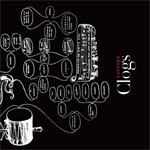|
|
 |
Dusted Reviews
Artist: Clogs Album: Lantern Label: Brassland Review date: Feb. 19, 2006 |

|
|
|
 |
Rock music and classical music rarely mix, and when they do the results almost always reek of overwrought pretension. Only a few (Glenn Branca, Rhys Chatham, and Louis Andriessen immediately come to mind) manage to cross the divide unscathed. And when members of indie-poppers the National try their hand at this project, one should take pause. Since they seem very strongly to want to be taken seriously – listing themselves as “composers” not “songwriters,” titling their songs with such classical references as “Death and the Maiden,” “5/4.” and “Canon,” and opening this album with a piece originally for lute by 17th century composer Johann Kapsburger – it should be evaluated based on its compositional merits.
1. Instrumentation
The choices one makes for instrumentation are critical for the overall tenor of the resultant piece, especially in a small ensemble. Most of Clogs’ choices make sense, particularly when they array the violin, guitars, bassoon, and percussion in pointillist textures. However, the second they try to utilize sustained tones in the violin and bassoon, all hell breaks loose, with the glaring timbral clashing distracting from the overall feel of the music. The most puzzling choices on Lantern, though, has to be the inclusion of steel drums and voice. Thankfully, the voice is limited to the title track, as it reeks of an attempt at seriousness that just rings hollow. But the steel drum is just completely unjustifiable, sounding completely out of place, reminding me more of those cheesy all-steel drum cover bands you see at festivals every so often. There are many other similar sounding instruments that could have been substituted without those horrific connotations.
2. Tempo
Variety is a good thing. Keeping the tempos at a maudlin pace through most of the album does very little to keep ones interest. Only in the latter third do Clogs finally decide to speed things up and incorporate more of a rock feel, like in “The Song of the Cricket,” which frolics along nicely, even hitting a (unfortunately truncated) Moondog-like groove for a few moments.
3. Repetition
It has been proven many times over the past 30 years that repetition and incremental building is a perfectly fine compositional device, but it must be used wisely, as a means toward an end. Particularly in the lugubrious opening half of the disc, Clogs tends to repeat things simply for the sake of repeating them without really building towards anything. Alternately, they won’t repeat their figure enough, cutting off a vamp well before its expiration date. While reaching a climax is musically satisfying, the gradual comedown from a climax can be even more satisfying, and they rarely allow that to happen.
4. Harmony
Simply put: harmony should never be used coercively. It is completely dishonest for a composer to try and manipulate the listener into feeling a certain set of emotions through chord progressions. In most of the slow pieces here, Clogs use minor keys and “poignant” progressions to attempt to show emotional depth and understanding but in fact only succeed in fulfilling post-rock clichés. When their harmonies become murkier and less predictable, as in “Compass” and “Voisins,” their emotional resonance becomes much stronger.
By Dan Ruccia
|







